Research subjects
Our laboratory is pursuing research on a complex field involving the science of photochemistry and biological functions based on the logic and measurement technology of electrochemistry. At the exit of that research there are hybrid elements created by molecular electronics, bioelectronics, bio-elements, and nanotechnology. These elements lead to the development of new energy conversion systems involving the light and environment surrounding our lives, and the development of sensors for optical information processing such as environmental sensing systems and retinal chips that are closely related to medical engineering.
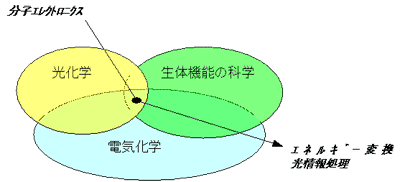
1. Solar energy conversion by dye sensitized semiconductor cell (applied electrochemistry field)
In the field of photoelectrochemistry concerning light and electrochemistry, semiconductor electrodes such as titanium oxide and zinc oxide have greatly developed. As an application to the industry, development of semiconductor photocatalyst is widely known. We are studying photoelectric conversion using a dye-sensitized porous semiconductor thin film as an application of photoelectrochemical research. This research has been actively studied in industry and academia as "engineering model of photosynthesis", but this laboratory aims to complete this technology in the form of environmental circulation type power generation element, and develops with a different viewpoint I am conducting research. First, the development of a technique to easily produce a semiconductor thin film fabricated by a firing process at a high temperature under a low environmental load at room temperature, secondly, development of a technique for making a cell using natural resources as much as possible as a material including an electrolytic solution and a pigment. We are concentrating on the method of making it. In addition, by using a flexible support such as a plastic substrate for the electrode substrate, we aim to expand the scope of applications to the fields of environment and medical engineering. Compete with the efficiency of silicon-based solar cells, instead of pursuing power generation elements that replace them, development that requires features that are not found in conventional power generation elements to be evaluated as flexible, uniform transparency, low environmental policy (green sustainable chemistry) to hold.
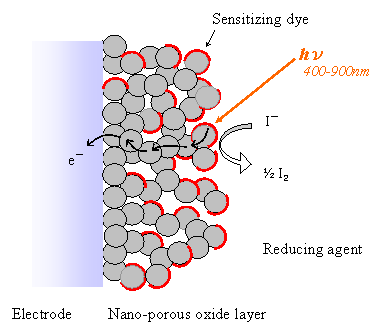
On this energy conversion study, the development of plastic film type photovoltaic cells is particularly emphasized now. Using a transparent conductive plastic film as a dye sensitizing electrode and a counter electrode, we have developed a photovoltaic film with a thickness of 300 μm or less, aiming to expand industrial applications that take advantage of its light weight and flexibility, We will aim for a significant cost reduction by the production process. Battery is an assembly technology that many members combine in series, research by industry-academia collaboration creates great effect. We have developed a proprietary "low temperature film formation of titania film by electrostatic electrodeposition" as the basic technology, realizing the process of completing the film type element at low temperature (<150 ° C) which does not hurt plastics, We are promoting high efficiency of its energy conversion efficiency. We are planning to send film photovoltaic cells that are made in this way, also excellent in processability and light transmission as industrial materials for consumer use for a wide range of purposes from outdoor use to indoor use and portable use.
2. Organic-inorganic hybrid solar cell using photosensitive perovskite crystal
(Material Engineering, Photovoltaic Physics Field)
Organo metal perovskite-based organic inorganic hybrid solar cells
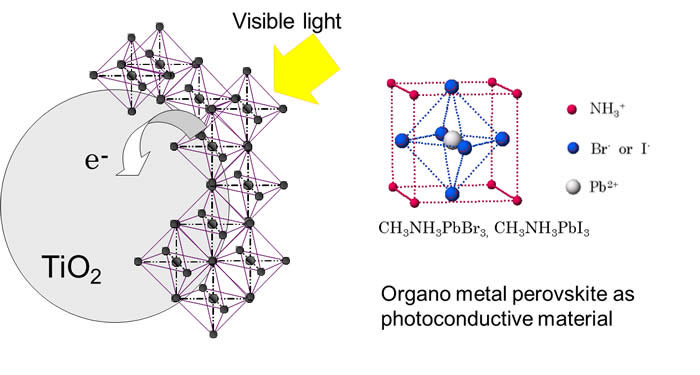
Photovoltaic cells with organic inorganic hybrid layered structures are capable of high conversion efficiency backed by strong light absorption and high voltage output. We are developing thin solid-state hybrid solar cells composed of mesoscopic TiO2, inorganic or hybrid photosensitive material, and solid hole conductor, based on solution-printable processes. Organo metal perovskite is a focus of our study. As visible light absorber and electron/hole conductor, it can be form by spin-coating to form a highly crystalline film whose spectral sensitivity can be tuned by changing chemical composition. Combined with a hole conductor SpiroOMeTAD, solid-state cell yields more than 10% conversion efficiency. Anthraquinone-bound thin TiO2 film is other example of photoelectrode for the hybrid solar cell. Combined with crystalline perylene as hole conductor layer the cell generated a high photovoltage of 1.2V. In this cell both of anthraquinone and perylene work as light absorbers. Other many structures of hybrid cell are designed in our laboratory toward realization of full printable technology of high performance hybrid solar cells.
Development of plastic film type solar cell
We have been developing technology to make DSC flexible film type photovoltaic cell. Currently, we are going to prototype a film type DSC (thickness 0.4 mm) with the world's highest efficiency. It can be made colorful depending on the color of the pigment, making it a light film type, making it into a window blind or panel, pasting it on a curved surface such as a bag, and expanding its application as a supplementary charging element for portable equipment. For this development, the low temperature film forming technology we developed (electrophoretic electrodeposition method and formation of titanium oxide semiconductor nanoparticle layer by chemical conversion treatment) is used. In addition to flexible, colorful, uniform transparency, low environmental load (Gurin Sustainability) not existing in conventional silicon solar cells, we aim to achieve substantial cost reduction by roll-to-roll production of film. Battery is an assembly technology that can combine many parts, and cooperation between production and academia creates great effect. While doing patent applications, we are preparing for joint development with companies that cooperate with research.
Reference: Publication of dye sensitized solar cell
http://kuroppe.icrs.tohoku.ac.jp/~masaki/wet_cell/outline-j.htm
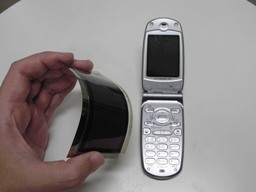
Film electrode to be bent
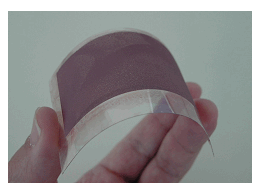
Business card sized film photovoltaic cell weighing 2 g
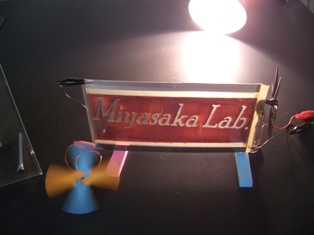
Large area DSC where characters are written by printing
Development of new element "optical capacitor"
In addition to generating electricity, we succeeded in the development of a new thin device "optical capacitor photocapacitor" that can store light energy directly as electric power (October 2004). In this element, a dye-sensitized nano-semiconductor layer is built in as a power generation layer and a carbonaceous material layer is built as a power storage layer, and it is an integrated electrostatic storage element capable of photoelectric storage. There are two types of electrodes, two-electrode type and three-electrode type, the latter being published as a former high voltage improvement type in June 2005 in Chem. Cummum. Magazine. Since the first solar cell solar cell was announced in 1954 at the Bell. Telephone Laboratories, the development of monolithic photovoltaic cell has started and it has been active for just half a century. At the University of Tokyo Segawa laboratory (joint research with Miyasaka laboratory), research on photovoltaic rechargeable batteries has yielded results.
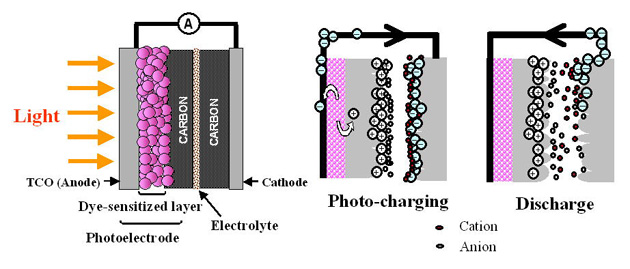
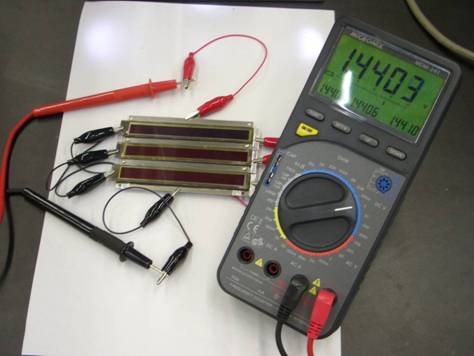
写真:光キャパシタの直列モジュール、出力1.4V
Fabrication of Flexible Optical Functional Device Using Polymer Material (Physicochemical Field)
A thin film element having an excellent quantum conversion function is manufactured by bonding a solid thin film of a polymer-containing material having excellent charge transfer ability with a photosensitive organic dye layer. A thin film having a hybrid structure of a polymer and an inorganic material is also used for function expression to derive the superiority of performance. This technology leads to high efficiency of all solid plastic optoelectronic devices replacing wet dye sensitized solar cells.
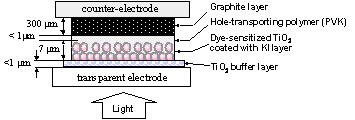
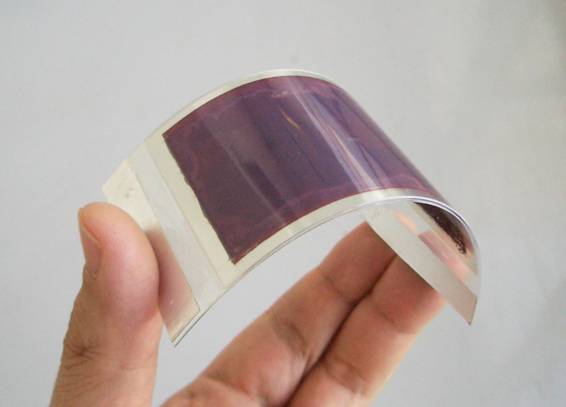
写真:カーボン複合材料によって作製したフレキシブルな固体型DSSC
3. Measurement of optical function of bacteriorhodopsin (family of retinal pigment) (Bioelectronics field)
Bacteriorhodopsin (BR) extracted from halophilus bacteria is a photosensitive dye attracting attention as another photosynthesis along with the photosynthesis of green plants where chlorophyll acts as a photosensitive dye. BR is a family of rhodopsin which is a pigment of the retina of animals, and is an extremely stable photosensitivity protein for heat and light made by bacteriorhodopsin. The pigment molecule corresponding to chlorophyll is a polyene called retinal, and it forms a Schiff base in the protein structure and binds. By light irradiation, BR performs extremely diverse photophysical changes (structural change, photochromism, charge transfer) and chemical reaction (unidirectional transport of protons). BR is exactly a molecular device with a treasure trove of optical function. In the laboratory, we extract BR-containing purple membranes from halophilic bacteria, prepare a monolayer of BR using LB method etc., and orient BR molecules by electric field method etc. The alignment film is immobilized on the electrode surface and its photoelectric response is measured under continuous light irradiation and under picosecond laser pulse irradiation. Such a BR thin film carrying electrode emits a unique electrical response similar to the retina. We have verified that this visually similar response characteristic can be applied to the design of artificial retinal element and so on. We are conducting further studies and are conducting research aimed at applying ultra-fast electrical response due to the structural change of BR to the fields of optical communication and optical information processing.
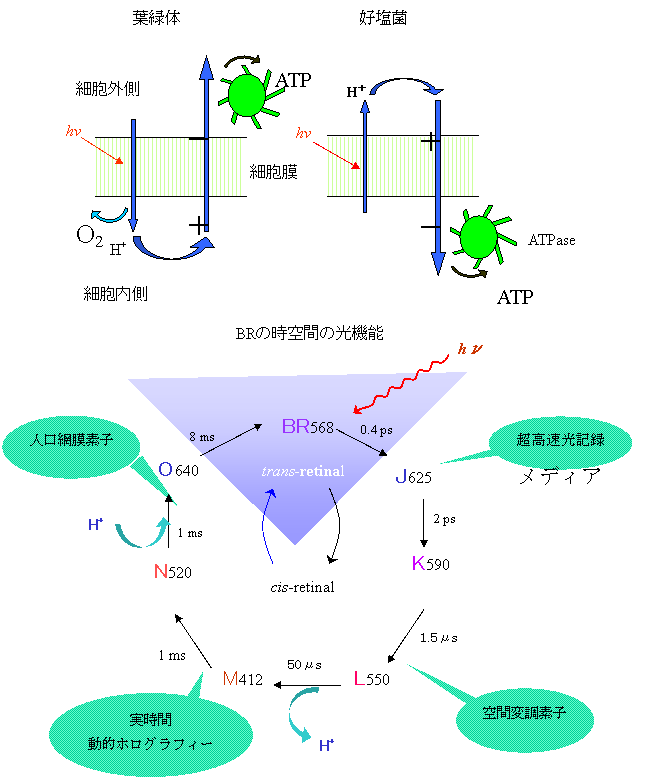
Design of Artificial Retinal Element Using Bacteriorhodopsin Thin Film
As a visual engineering visual prosthetic technology for hundreds of thousands of blind people and amblyopic patients, there is the creation of artificial retina. The photosensitive protein bacteriorhodopsin (BR) can be regarded as a rare biomaterial that can output the function of this artificial retina. In the laboratory, cultivating halophilic bacteria to purify purple membranes containing BR, converting this into super thin films with aligned orientation using LB method (Professor Miura sensei, Department of Functional Chemistry Engineering) It fixes to the plastic film electrode and converts the optical signal into a characteristic electric signal. Thin film fabrication is a collaborative research with Professor Tadashi Watanabe of the University of Tokyo (part-time lecturer at Graduate School of Engineering, Bioelectrochem.), But this year's research is aimed at measuring the high-speed electrical response using a picosecond pulsed laser, We will also develop into evaluation research. BR is a retinal pigment family, but it is a protein that is extremely stable for heat and light. Based on research on orientation evaluation, we will develop researches to apply BR's unique photoelectric response to artificial retina, optical communication and optical information processing.
4. Sensing of DNA using optical functional interface (Nanomedical Science field)
In the field of medical engineering, ultra trace detection of DNA has been practiced by fluorescence labeling method and image analysis. However, this method requires expensive equipment and there is a problem that quantitative detection is not good. On the other hand, detection of DNA by electrochemical technique is simple and quantitative. We developed for the first time a method to detect the presence of DNA as a photoelectric response spectrum based on the sensitized photocurrent that the DNA double helix labeled or intercalated on the oxide electrode provides on the oxide electrode. Electrical response can be amplified in the circuit and high detection sensitivity can be obtained. By differentiating different kinds of DNA as waveforms of the action spectrum, it is possible to quantitatively detect multiple DNA simultaneously. Nanostructures on electrodes are also successfully used for this sensing method, and it can be expected to apply this technology to the hybridization of DNA using nanospace and its detection.
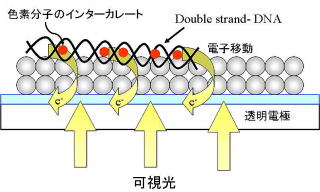
5. Study on Photodynamic therapy by photosensitive nano ultrafine particles
This research is pursuing the possibility of proactively applying the nanochemistry technology cultivated above to medical engineering. Preparation of photosensitive nanoparticles, incubation on cells, observation of cell-killing effect by irradiation with visible light, in collaboration with the Kawashima laboratory at the Advanced Medical Engineering Center. Photosensitive nanoparticles containing semiconducting ultrafine particles are synthesized in various ways, and the stable dispersion is purified for injection into living organisms. One purpose is to make use of technology for cancer treatment.
